 Intent
Intent Intent
IntentConvert the interface of a class into another interface clients expect. Adapter lets classes work together that couldn't otherwise because of incompatible interfaces.
 Also Known As
Also Known AsWrapper
 Motivation
MotivationSometimes a toolkit class that's designed for reuse isn't reusable only because its interface doesn't match the domain-specific interface an application requires.
Consider for example a drawing editor that lets users draw and arrange graphical elements (lines, polygons, text, etc.) into pictures and diagrams. The drawing editor's key abstraction is the graphical object, which has an editable shape and can draw itself. The interface for graphical objects is defined by an abstract class called Shape. The editor defines a subclass of Shape for each kind of graphical object: a LineShape class for lines, a PolygonShape class for polygons, and so forth.
Classes for elementary geometric shapes like LineShape and PolygonShape are rather easy to implement, because their drawing and editing capabilities are inherently limited. But a TextShape subclass that can display and edit text is considerably more difficult to implement, since even basic text editing involves complicated screen update and buffer management. Meanwhile, an off-the-shelf user interface toolkit might already provide a sophisticated TextView class for displaying and editing text. Ideally we'd like to reuse TextView to implement TextShape, but the toolkit wasn't designed with Shape classes in mind. So we can't use TextView and Shape objects interchangeably.
How can existing and unrelated classes like TextView work in an application that expects classes with a different and incompatible interface? We could change the TextView class so that it conforms to the Shape interface, but that isn't an option unless we have the toolkit's source code. Even if we did, it wouldn't make sense to change TextView; the toolkit shouldn't have to adopt domain-specific interfaces just to make one application work.
Instead, we could define TextShape so that it adapts the TextView interface to Shape's. We can do this in one of two ways: (1) by inheriting Shape's interface and TextView's implementation or (2) by composing a TextView instance within a TextShape and implementing TextShape in terms of TextView's interface. These two approaches correspond to the class and object versions of the Adapter pattern. We call TextShape an adapter.
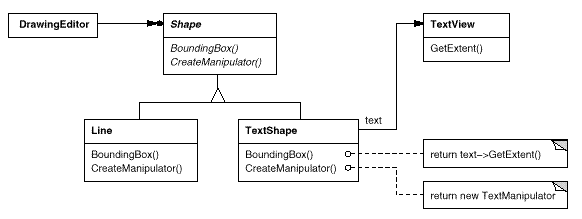
This diagram illustrates the object adapter case. It shows how BoundingBox requests, declared in class Shape, are converted to GetExtent requests defined in TextView. Since TextShape adapts TextView to the Shape interface, the drawing editor can reuse the otherwise incompatible TextView class.
Often the adapter is responsible for functionality the adapted class doesn't provide. The diagram shows how an adapter can fulfill such responsibilities. The user should be able to "drag" every Shape object to a new location interactively, but TextView isn't designed to do that. TextShape can add this missing functionality by implementing Shape's CreateManipulator operation, which returns an instance of the appropriate Manipulator subclass.
Manipulator is an abstract class for objects that know how to animate a Shape in response to user input, like dragging the shape to a new location. There are subclasses of Manipulator for different shapes; TextManipulator, for example, is the corresponding subclass for TextShape. By returning a TextManipulator instance, TextShape adds the functionality that TextView lacks but Shape requires.
 Applicability
ApplicabilityUse the Adapter pattern when
 Structure
StructureA class adapter uses multiple inheritance to adapt one interface to another:
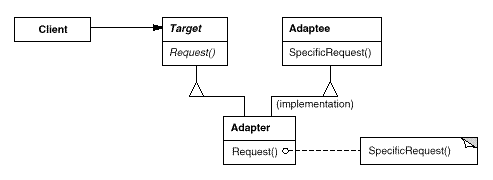
An object adapter relies on object composition:
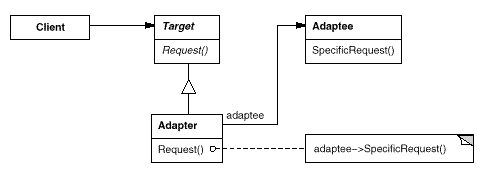
 Participants
Participants Collaborations
Collaborations Consequences
ConsequencesClass and object adapters have different trade-offs. A class adapter
An object adapter
Here are other issues to consider when using the Adapter pattern:
Consider a TreeDisplay widget that can display tree structures graphically. If this were a special-purpose widget for use in just one application, then we might require the objects that it displays to have a specific interface; that is, all must descend from a Tree abstract class. But if we wanted to make TreeDisplay more reusable (say we wanted to make it part of a toolkit of useful widgets), then that requirement would be unreasonable. Applications will define their own classes for tree structures. They shouldn't be forced to use our Tree abstract class. Different tree structures will have different interfaces.
In a directory hierarchy, for example, children might be accessed with a GetSubdirectories operation, whereas in an inheritance hierarchy, the corresponding operation might be called GetSubclasses. A reusable TreeDisplay widget must be able to display both kinds of hierarchies even if they use different interfaces. In other words, the TreeDisplay should have interface adaptation built into it.
We'll look at different ways to build interface adaptation into classes in the Implementation section.
Consider the two-way adapter that integrates Unidraw, a graphical editor framework [VL90], and QOCA, a constraint-solving toolkit [HHMV92]. Both systems have classes that represent variables explicitly: Unidraw has StateVariable, and QOCA has ConstraintVariable. To make Unidraw work with QOCA, ConstraintVariable must be adapted to StateVariable; to let QOCA propagate solutions to Unidraw, StateVariable must be adapted to ConstraintVariable.
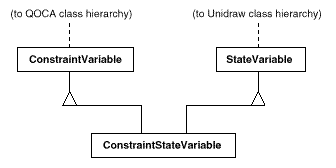
The solution involves a two-way class adapter ConstraintStateVariable, a subclass of both StateVariable and ConstraintVariable, that adapts the two interfaces to each other. Multiple inheritance is a viable solution in this case because the interfaces of the adapted classes are substantially different. The two-way class adapter conforms to both of the adapted classes and can work in either system.
 Implementation
ImplementationAlthough the implementation of Adapter is usually straightforward, here are some issues to keep in mind:
The first step, which is common to all three of the implementations discussed here, is to find a "narrow" interface for Adaptee, that is, the smallest subset of operations that lets us do the adaptation. A narrow interface consisting of only a couple of operations is easier to adapt than an interface with dozens of operations. For TreeDisplay, the adaptee is any hierarchical structure. A minimalist interface might include two operations, one that defines how to present a node in the hierarchical structure graphically, and another that retrieves the node's children.
The narrow interface leads to three implementation approaches:
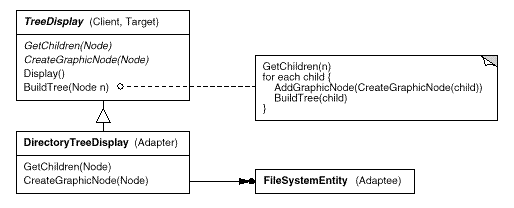
DirectoryTreeDisplay specializes the narrow interface so that it can display directory structures made up of FileSystemEntity objects.
For example, suppose there exists a DirectoryBrowser that uses a TreeDisplay. DirectoryBrowser might make a good delegate for adapting TreeDisplay to the hierarchical directory structure. In dynamically typed languages like Smalltalk or Objective C, this approach only requires an interface for registering the delegate with the adapter. Then TreeDisplay simply forwards the requests to the delegate. NEXTSTEP [Add94] uses this approach heavily to reduce subclassing.
Statically typed languages like C++ require an explicit interface definition for the delegate. We can specify such an interface by putting the narrow interface that TreeDisplay requires into an abstract TreeAccessorDelegate class. Then we can mix this interface into the delegate of our choice—DirectoryBrowser in this case—using inheritance. We use single inheritance if the DirectoryBrowser has no existing parent class, multiple inheritance if it does. Mixing classes together like this is easier than introducing a new TreeDisplay subclass and implementing its operations individually.
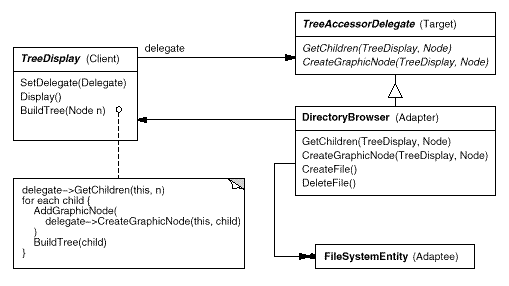
For example, to create TreeDisplay on a directory hierarchy, we write
directoryDisplay :=
(TreeDisplay on: treeRoot)
getChildrenBlock:
[:node | node getSubdirectories]
createGraphicNodeBlock:
[:node | node createGraphicNode].
If you're building interface adaptation into a class, this approach offers a convenient alternative to subclassing.
 Sample Code
Sample CodeWe'll give a brief sketch of the implementation of class and object
adapters for the Motivation example beginning with the classes
Shape and TextView.
class Shape {
public:
Shape();
virtual void BoundingBox(
Point& bottomLeft, Point& topRight
) const;
virtual Manipulator* CreateManipulator() const;
};
class TextView {
public:
TextView();
void GetOrigin(Coord& x, Coord& y) const;
void GetExtent(Coord& width, Coord& height) const;
virtual bool IsEmpty() const;
};
Shape assumes a bounding box defined by its opposing
corners. In contrast, TextView is defined by an origin,
height, and width. Shape also defines a
CreateManipulator operation for creating a
Manipulator object, which knows how to animate a shape
when the user manipulates it.1 TextView has no
equivalent operation. The class TextShape is an
adapter between these different interfaces.
A class adapter uses multiple inheritance to adapt interfaces. The key
to class adapters is to use one inheritance branch to inherit the
interface and another branch to inherit the implementation. The usual
way to make this distinction in C++ is to inherit the interface
publicly and inherit the implementation privately. We'll use this
convention to define the TextShape adapter.
class TextShape : public Shape, private TextView {
public:
TextShape();
virtual void BoundingBox(
Point& bottomLeft, Point& topRight
) const;
virtual bool IsEmpty() const;
virtual Manipulator* CreateManipulator() const;
};
The BoundingBox operation converts TextView's
interface to conform to Shape's.
void TextShape::BoundingBox (
Point& bottomLeft, Point& topRight
) const {
Coord bottom, left, width, height;
GetOrigin(bottom, left);
GetExtent(width, height);
bottomLeft = Point(bottom, left);
topRight = Point(bottom + height, left + width);
}
The IsEmpty operation demonstrates the direct forwarding of
requests common in adapter implementations:
bool TextShape::IsEmpty () const {
return TextView::IsEmpty();
}
Finally, we define CreateManipulator (which isn't supported
by TextView) from scratch. Assume we've already implemented
a TextManipulator class that supports manipulation of a
TextShape.
Manipulator* TextShape::CreateManipulator () const {
return new TextManipulator(this);
}
The object adapter uses object composition to combine classes with
different interfaces. In this approach, the adapter
TextShape maintains a pointer to
TextView.
class TextShape : public Shape {
public:
TextShape(TextView*);
virtual void BoundingBox(
Point& bottomLeft, Point& topRight
) const;
virtual bool IsEmpty() const;
virtual Manipulator* CreateManipulator() const;
private:
TextView* _text;
};
TextShape must initialize the pointer to the
TextView instance, and it does so in the constructor. It
must also call operations on its TextView object whenever
its own operations are called. In this example, assume that the client
creates the TextView object and passes it to the
TextShape constructor:
TextShape::TextShape (TextView* t) {
_text = t;
}
void TextShape::BoundingBox (
Point& bottomLeft, Point& topRight
) const {
Coord bottom, left, width, height;
_text->GetOrigin(bottom, left);
_text->GetExtent(width, height);
bottomLeft = Point(bottom, left);
topRight = Point(bottom + height, left + width);
}
bool TextShape::IsEmpty () const {
return _text->IsEmpty();
}
CreateManipulator's implementation doesn't change
from the class adapter version, since it's implemented from scratch
and doesn't reuse any existing TextView functionality.
Manipulator* TextShape::CreateManipulator () const {
return new TextManipulator(this);
}
Compare this code to the class adapter case. The object adapter
requires a little more effort to write, but it's more flexible. For
example, the object adapter version of TextShape will work
equally well with subclasses of TextView---the client simply
passes an instance of a TextView subclass to the
TextShape constructor.
 Known Uses
Known UsesThe Motivation example comes from ET++Draw, a drawing application based on ET++ [WGM88]. ET++Draw reuses the ET++ classes for text editing by using a TextShape adapter class.
InterViews 2.6 defines an Interactor abstract class for user interface elements such as scroll bars, buttons, and menus [VL88]. It also defines a Graphic abstract class for structured graphic objects such as lines, circles, polygons, and splines. Both Interactors and Graphics have graphical appearances, but they have different interfaces and implementations (they share no common parent class) and are therefore incompatible—you can't embed a structured graphic object in, say, a dialog box directly.
Instead, InterViews 2.6 defines an object adapter called GraphicBlock, a subclass of Interactor that contains a Graphic instance. The GraphicBlock adapts the interface of the Graphic class to that of Interactor. The GraphicBlock lets a Graphic instance be displayed, scrolled, and zoomed within an Interactor structure.
Pluggable adapters are common in
ObjectWorks\Smalltalk [Par90]. Standard Smalltalk defines
a ValueModel class for views that display a single value. ValueModel
defines a value, value: interface for accessing
the value. These are abstract methods. Application writers access the
value with more domain-specific names like width and
width:, but they shouldn't have to subclass ValueModel
to adapt such application-specific names to the ValueModel interface.
Instead, ObjectWorks\Smalltalk includes a subclass of ValueModel
called PluggableAdaptor. A PluggableAdaptor object adapts other
objects to the ValueModel interface (value,
value:). It can be parameterized with blocks for getting
and setting the desired value. PluggableAdaptor uses these blocks
internally to implement the
value, value: interface. PluggableAdaptor also
lets you pass in the selector names (e.g., width,
width:) directly for syntactic convenience.
It converts these selectors into the corresponding blocks
automatically.
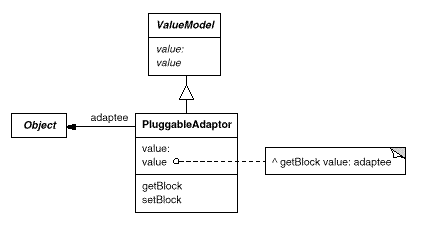
Another example from ObjectWorks\Smalltalk is the TableAdaptor class. A TableAdaptor can adapt a sequence of objects to a tabular presentation. The table displays one object per row. The client parameterizes TableAdaptor with the set of messages that a table can use to get the column values from an object.
Some classes in NeXT's AppKit [Add94] use delegate objects to perform interface adaptation. An example is the NXBrowser class that can display hierarchical lists of data. NXBrowser uses a delegate object for accessing and adapting the data.
Meyer's "Marriage of Convenience" [Mey88] is a form of class adapter. Meyer describes how a FixedStack class adapts the implementation of an Array class to the interface of a Stack class. The result is a stack containing a fixed number of entries.
 Related Patterns
Related PatternsBridge (151) has a structure similar to an object adapter, but Bridge has a different intent: It is meant to separate an interface from its implementation so that they can be varied easily and independently. An adapter is meant to change the interface of an existing object.
Decorator (175) enhances another object without changing its interface. A decorator is thus more transparent to the application than an adapter is. As a consequence, Decorator supports recursive composition, which isn't possible with pure adapters.
Proxy (207) defines a representative or surrogate for another object and does not change its interface.
1CreateManipulator is an example of a
Factory Method (107).
